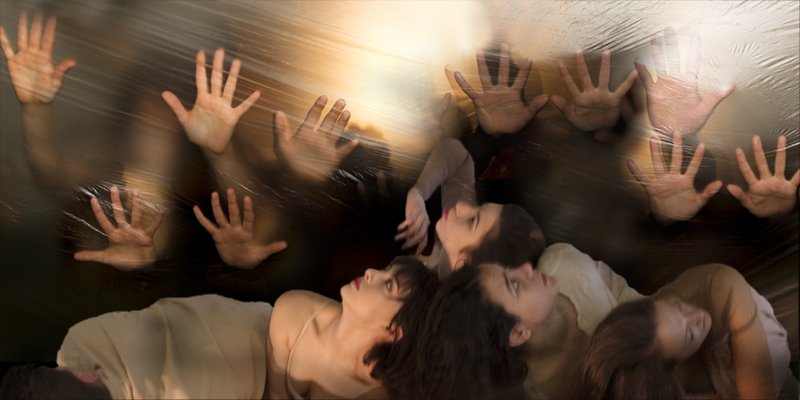CHICAGO — The two pieces which make up Hedwig Dances’s spring series are positioned as opposites. The evening, called Sea Level: Above and Below, boasts world premieres by company members Taimy Ramos and Rigoberto Saura. It’s an apt juxtaposition: the murky groundedness of Ramos’s “A Flor de Piel” gives a sense of the dark abyss beneath the ocean’s surface, while Saura’s “The Flowering Mechanisms” is comparatively light and frothy.
But it’s a bit more nuanced than that.
Having their final performances Saturday at the Ruth Page Center for the Arts, “The Flowering Mechanisms” and “A Flor de Piel” are more like two sides of the same coin; rather than black and white, Sea Level operates in shades of gray.
The similarities between Ramos and Saura’s choreographic styles are an extension of their common training at Havana’s National School of Dance. Each of them is rather new to dancemaking, but very clearly informed by Hedwig artistic director Jan Bartoszek. There’s a virile curiosity about these two pieces, which equally aim to exhaust every possibility the body can find within a particular prop, gesture or theme. The evening is marked by inventive, difficult partnering; an attentiveness to their chosen composers’ creations — an orchestral score by Mason W. Bates in “The Flowering Mechanisms” and a driving maelstrom by J-Lawton in “A Flor de Piel” — a keen sense of line and the dancers’ relationships to the space.
So it seems these two works are more alike than they are different, and that might be true. One last case on that point: a thing that excites me about this program is the choreographers’ perseverance to dancing. Of late in smaller venues and on the storefront scene, multi-disciplinary performance rules the roost. Few are the young makers committed to finding their artistic voices wholly within the body, mined from a deep investigation informed by decades of technical training. Why? In part, because it’s really hard to do, and I imagine audiences have a somewhat easier time finding the through-lines of a work which leans more on the forms of expression we use every day.
Saura’s quintet features Hedwig’s four women and the towering Jacob Buerger, whose long limbs are echoed in a portable rectangular set piece that doubles as a projection surface. On it, a variety of screen saver-type images — an exploding supernova, a quiet country scene and power lines, for example — hint at a theme of how mechanization has changed the world. What does that have to do with supernovas? One gets the sense that human progress, which has been advanced and driven increasingly by computers and machines, is an unsustainable path, leaving me with a building urge for stillness on stage. We don’t quite get that, but the itchiness created by Saura’s ever-rising intensity is relieved by an enigmatic figure portrayed by Jessie Gutierrez. Gutierrez swops her dusty gray leotard — which matches the rest of her colleagues — for a red sequined evening gown. If Dorothy’s shoes were a dress, they’d look like this, which is maybe just the right metaphor: “There’s no place like home.” When we think about the uncertainty of the chaotic times we live in, it’s tempting to crave a simpler existence, a “remember when,” an idyllic America that we perceive existed once, “way back when,” regardless of whether it’s real or imagined.
Translated to mean “Skin Deep,” “A Flor de Piel” employs plastic sheeting to create three translucent hideaways for the cast of six, including Ramos, to duck in and out of. The key to success here is bold, colorless lanes of light by Sarah Lackner, foreshadowing these reems of plastic strung lengthwise over an invisible tie line hung above the stage, and her use of backlight positioned on the Ruth Page’s “upper stage,” creating a thin skin like a fogged up shower door. Palms gently pressed against this delicate sheath are mirrored by Ramos’s outstretched fingers against the downstage side of this set as she explores, with wonder, what lies on the other side.
It is just one of so many images Ramos puts forward in a work that should have felt too long, but didn’t. Those plastic sheets are used to blindfold and bind Olivia Gonzalez, like an intricate, macabre game of toilet paper bride. Gonzalez then ties Saura’s hands behind his back with the top half of his black jump suit as Buerger, wearing a huge placard created by Ramos depicting what looks like an intricate sugar skull, plods the perimeter of the space.
I was tempted to see the artist’s heavy burden in these moments — that we are bound, blindfolded and oppressed by that which we love and sacrifice for. Maybe this is a step too far as a takeaway from “A Flor de Piel.”
Maybe not.
—
SEA LEVEL: Above and Below shows Saturday, March 23, 7:30pm at the Ruth Page Center for the Arts, 1016 North Dearborn St. Tickets are $10-25, available online at bit.ly/HedwigDances_SEALEVEL and at the door.
